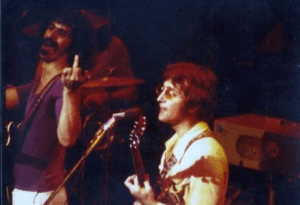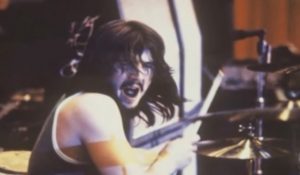11 Times Rush Proved They Were the Smartest Band in Rock

via RushWire / YouTube
Few bands have ever balanced intellect and power quite like Rush. Across decades of relentless touring and mind-bending albums, the Canadian trio turned complex time signatures, literary lyrics, and philosophical concepts into stadium-sized anthems. They managed to make brainy music feel exhilarating — a rare feat in rock, where subtlety and scholarship often take a back seat to swagger.
What set Rush apart wasn’t just their technical mastery but their curiosity. Every album seemed like an experiment — in sound, storytelling, or sheer audacity. Whether they were weaving Ayn Rand references into epic suites or exploring science fiction and social commentary, Rush invited listeners to think as much as they rocked out. The result was a catalog that challenged convention while staying unmistakably their own.
Through meticulous musicianship and fearless creativity, Rush built a legacy that celebrates both intelligence and emotion. They didn’t just play songs; they engineered them. And time after time, they proved that rock could be as thoughtful as it was thunderous. Here are 11 moments when Rush reminded everyone why they might just be the smartest band in rock.
1. Writing a 20-Minute Sci-Fi Masterpiece Before Anyone Else
By the mid-’70s, Rush faced a crossroads. Their third album, Caress of Steel, had flopped commercially, and their label, Mercury Records, pushed them to write shorter, radio-friendly songs. Instead, they doubled down on ambition. With 2112 (1976), the trio composed an 20-minute suite inspired by Ayn Rand’s Anthem — a futuristic fable about individuality and creative freedom. It was a bold act of defiance that could have ended their career.
But that gamble paid off spectacularly. 2112 not only restored their standing but also became one of the defining statements of progressive rock. The story — of a man who discovers music in a totalitarian world that bans art — mirrored Rush’s own struggle for creative autonomy. It was both conceptually daring and musically electrifying, a blend of science fiction and philosophy that no other rock act had attempted with such clarity.
In doing so, Rush created a new kind of epic. It wasn’t fantasy for fantasy’s sake; it was an allegory about freedom and the human spirit. For fans and musicians alike, 2112 became a reminder that intellect and rebellion could coexist — and that rock could be grand without losing its soul.
2. Neil Peart’s Lyrics Were Basically Literature
When Neil Peart joined Rush in 1974, he didn’t just bring drum virtuosity — he brought a library’s worth of ideas. His lyrics were steeped in literature, philosophy, and social commentary, making him one of rock’s true wordsmiths. Songs like Xanadu drew from Samuel Taylor Coleridge, while The Trees used allegory to explore equality and conflict. Peart treated songwriting as authorship, crafting narratives and meditations instead of simple choruses.
His pen turned Rush’s albums into intellectual journeys. Permanent Waves questioned free will; Moving Pictures dissected fame and modern life; Clockwork Angels, decades later, explored destiny through steampunk mythology. Every line carried weight — not just for how it sounded, but for what it meant. Fans weren’t just singing along; they were analyzing.
Even critics who dismissed prog rock’s excess had to acknowledge Peart’s mind. Few drummers could quote Camus or Nietzsche in interviews with the same ease they could play a 7/8 fill. Through Peart, Rush became a band that challenged listeners to think, proving that poetry could thrive in arenas packed with thousands of fans.
https://twitter.com/20th_Centurygal/status/1966478042772942849
3. Turning Complex Time Signatures Into Radio Hits
Progressive rock was never meant for FM radio — until Rush came along. Songs like Tom Sawyer and Limelight broke every commercial rule and still became staples of classic-rock playlists. The secret was their precision: Geddy Lee’s melodic bass, Alex Lifeson’s guitar interplay, and Neil Peart’s mathematical drumming created hooks out of rhythms most musicians wouldn’t dare attempt.
Tom Sawyer, for instance, famously shifts between 4/4 and 7/8, yet feels effortlessly natural. The song’s balance of groove and intellect turned it into a universal anthem — proof that you didn’t have to dumb things down to reach the masses. Rush made complexity sound cool, a feat few bands have ever replicated.
Their ability to merge heady musicianship with emotional punch was their true genius. Listeners might not have known they were tapping their feet to an asymmetric beat, but they felt it. Rush made the technical invisible — the ultimate sign of mastery.
4. “YYZ” — When an Airport Code Became a Prog Anthem
Only Rush could turn something as mundane as an airport code into one of the most exhilarating instrumentals in rock. YYZ, from Moving Pictures (1981), was inspired by the Morse code rhythm for Toronto Pearson International Airport — the band’s home base. That sequence (Y-Y-Z) became the song’s main riff, setting the stage for a jaw-dropping display of technical interplay.
What followed was three and a half minutes of controlled chaos. Each member — Lee, Lifeson, and Peart — took turns pushing the composition into uncharted territory, yet it never lost its sense of structure or purpose. It was a masterclass in communication, a kind of musical conversation where every note had intention.
YYZ went on to earn a Grammy nomination and became a live favorite, celebrated by musicians for its precision and playfulness alike. Beyond the sheer virtuosity, it showcased Rush’s knack for turning intellect into art — finding creativity in the unlikeliest of sources, even an airport identifier.
5. Making Synths Sound Intellectual, Not Cheesy
By the 1980s, synthesizers had flooded popular music, often drowning it in gloss and excess. But Rush approached the technology differently. Rather than using synths as decoration, they made them integral to their storytelling. On Signals (1982) and Grace Under Pressure (1984), the electronic textures became emotional conduits — especially in Subdivisions, a song that captured the alienation of growing up in uniform suburbs.
Where others chased trends, Rush used technology to serve meaning. The synths pulsed with purpose, underscoring Peart’s lyrics about conformity, loneliness, and self-discovery. Geddy Lee’s keyboards added an intellectual depth that mirrored the anxieties of the modern age — precise, cold, but deeply human.
In embracing synthesizers, Rush proved that progress didn’t mean abandoning soul. They evolved without compromise, turning what could have been a dated 1980s sound into timeless art. For a band obsessed with progress, it was yet another reminder: they were always one step ahead.
https://twitter.com/AMH5150/status/1920968125593358583
6. Playing Like Three People Doing the Work of Six
Rush’s live shows were miracles of coordination. Long before laptops and digital assistance became the norm, Geddy Lee, Alex Lifeson, and Neil Peart recreated their densely layered studio recordings entirely by hand. Lee, in particular, was a marvel — singing complex vocal lines while playing bass with one hand and triggering keyboard parts or foot-controlled synth pedals with the other. It was multitasking on a level most musicians wouldn’t dare attempt.
The trio’s synergy was the real magic. Each performance felt like an act of engineering precision — guitar textures and bass lines locking perfectly around Peart’s rhythmic frameworks. Their concerts weren’t about spectacle or pyrotechnics; the spectacle was the musicianship. Fans could see every part being played in real time, and that transparency only deepened the awe.
In an era when many acts relied on overdubs or extra players, Rush proved that a band didn’t need numbers to sound massive. Three instruments, flawlessly synchronized, could conjure the density of an orchestra. It was the sound of discipline meeting imagination — the essence of why Rush concerts felt superhuman.
7. Sneaking Deep Philosophy Into Arena Rock
Rush never treated their audience like they couldn’t handle big ideas. In fact, they trusted them with some of rock’s most profound lyrical explorations. Tracks like Freewill wrestled with questions of choice and destiny, while The Trees offered allegory about equality and resentment. Closer to the Heart distilled compassion and wisdom into a radio-friendly anthem that somehow made philosophy singable.
What set these songs apart was their balance between thought and emotion. Peart’s lyrics invited contemplation, but the melodies and arrangements kept everything accessible. The result was arena rock that encouraged reflection — proof that intelligence and popularity weren’t mutually exclusive. Fans could chant along to Freewill at full volume and still leave thinking about determinism afterward.
Rush essentially tricked mainstream rock into reading philosophy. In an age defined by hedonism and simplicity, they slipped depth into the conversation — not as elitism, but as an invitation. They made thinking feel powerful, turning ideas that belonged in lecture halls into lyrics that filled stadiums.
8. The Drum Solos That Became Storytelling
Neil Peart’s drum solos weren’t mere exhibitions of technique — they were journeys. Across decades, he transformed what could have been a self-indulgent showcase into a form of narrative expression. From early live staples like Working Man to later masterpieces like The Rhythm Method and O Baterista, each solo evolved as a living piece of art. Peart used acoustic kits, electronic pads, and even orchestral percussion to tell stories through rhythm.
Audiences never knew exactly where he’d go next. One minute he was channeling African polyrhythms; the next, he was weaving in swing jazz or digital effects synced to lighting cues. Every performance was a dialogue between man and machine — an exploration of how far a drummer could push the instrument without losing humanity.
By the 2000s, Peart’s solos had become legendary moments of theater within the setlist — part performance art, part meditation. They reminded everyone that drumming could be intellectual, emotional, and cinematic all at once. In his hands, percussion wasn’t background noise; it was storytelling in its purest, most primal form.
9. Always Evolving — Never Repeating Themselves
If there’s one constant in Rush’s story, it’s change. From their early hard rock days on Fly by Night and Caress of Steel to the sleek precision of Moving Pictures and the conceptual sweep of Clockwork Angels, the band treated every album as a laboratory for experimentation. They never clung to a formula, even when it would have been profitable to do so. Instead, they chased progress — sometimes literally, sometimes sonically.
That restlessness defined their genius. When guitar-driven rock began to fade in the late ’70s, they embraced synthesizers. When synths became overused, they pivoted back to organic tones. Even their late-career material, long after most bands had settled into nostalgia, still explored new textures and themes. Clockwork Angels (2012) proved they could craft a modern concept album that felt timeless — proof that curiosity never aged.
In constantly reinventing themselves, Rush set a model for creative integrity. They didn’t follow trends; they studied them, absorbed what mattered, and moved on. For Rush, evolution wasn’t a risk — it was the only way to stay alive as artists.
10. Staying Humble Despite Being Untouchable
For all their technical mastery and global fame, Rush never carried themselves like rock royalty. There were no scandals, feuds, or diva antics — just three lifelong friends with a deep respect for one another and for their audience. They showed up on time, played flawlessly, and thanked their fans with genuine warmth. In an industry obsessed with ego, they were the rare example of humility and humor coexisting with brilliance.
Their behind-the-scenes reputation was legendary. Crew members often said touring with Rush felt like joining a family, not a corporation. The band made a point of knowing everyone’s name, ensuring no one was treated as “just staff.” Even when inducted into the Rock & Roll Hall of Fame in 2013 — after years of being snubbed — they celebrated the moment with laughter and gratitude rather than bitterness.
That humility became part of their mythos. Rush proved that being exceptional didn’t mean being arrogant. They reminded fans that intellect and kindness weren’t opposites — they were complementary forces that made their art (and their legacy) shine even brighter.
https://twitter.com/oriettamusic/status/1869907386372141453
11. Retiring With Dignity, Not Drama
Rush’s ending was as thoughtful as their music. After decades of relentless touring and recording, the band embarked on their 40th anniversary R40 tour in 2015, fully aware it would likely be their last. Neil Peart’s chronic health issues — including tendon problems and later, a devastating brain cancer diagnosis — made performing increasingly difficult. But rather than drag things out, the band chose to leave the stage gracefully, on their own terms.
There were no farewell gimmicks or half-hearted reunions. Just one final, meticulously crafted tour that celebrated their career with humor, heart, and humility. When it ended, Geddy Lee and Alex Lifeson made it clear: Rush would not continue without Neil. It was an act of integrity that few bands could match in an industry known for endless comebacks.
Their quiet exit only reinforced what made them special. Rush left fans not with chaos or controversy, but with gratitude — and the satisfaction of knowing they ended as they lived: disciplined, united, and infinitely respectful of the music that defined them.
















